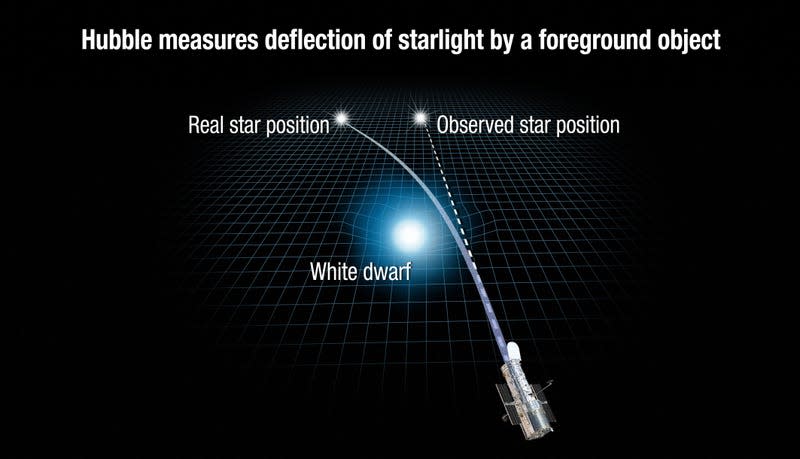Hubble Telescope Directly Measures a White Dwarf Mass for the First Time

A view of LAWD 37 as seen by Hubble.
Astronomers just directly measured the mass of a lone white dwarf using the Hubble Space Telescope for the first time. The dwarf—the core remnant of a star—is named LAWD 37, and it burned out about a billion years ago.
Using Hubble, a team of astronomers watched light from a background star briefly bend around the dwarf as the latter transited in front of the former. Based on how much of the background light was lensed by the dwarf, the researchers were able to determine its mass. Their results were published in the Monthly Notices of the Royal Astronomical Society.
Read more
These Winning Close-Up Photos Show Life That's Often Overlooked
Remembering Enterprise: The Test Shuttle That Never Flew to Space
Kailash Sahu, a co-author of the new paper, previously measured a white dwarf mass for a stellar remnant in a binary system. “Our latest observation provides a new benchmark because LAWD 37 is all by itself,” Sahu said in a European Space Agency release.
Though LAWD 37 is no longer undergoing nuclear fusion, the star’s surface is still a roiling 180,000° Fahrenheit (100,000° C). The stellar remnant, located about 15 light-years from Earth, is now about 56% the mass of our Sun.
The method used to determine the dwarf’s mass—gravitational microlensing—is a small-scale version of gravitational lensing, in which a massive object warps space such that light from behind it bends around the object, allowing us to see things that would otherwise be hidden. The lensing effect also magnifies the light, so we can see things that might otherwise be too faint to detect.
Last year, for example, Earendel, a nearly 13-billion-year-old star, was spotted thanks to this natural magnifying glass phenomenon.

To make their measurement of LAWD 37, the team had to wait for the dwarf to pass in front of the background star, an event that was predictable thanks to data from the ESA’s Gaia mission. Then, the researchers carefully parsed the light from the background star from the overwhelming glare of the much-nearer LAWD 37.
“The size of our measured offset is like measuring the length of a car on the Moon as seen from Earth,” said Peter McGill, an astronomer at UC Santa Cruz and the paper’s lead author, in the ESA release. “The glare from the white dwarf can cause streaks in unpredictable directions, meaning we had to analyze each of Hubble’s observations extremely carefully, and their limitations, to model the event and estimate the mass of LAWD 37.”
With this information, astronomers will be able to test the relationship between mass and radius for other white dwarfs, in turn revealing more information about how matter works under such extreme gravitational conditions.
Eventually—that is, in about 5 billion years—our Sun will also become a white dwarf. When it runs out of fuel for its nuclear fusion, the Sun will go through its own dramatic death sequence, potentially leaving a glowing nebula in its wake.
The Webb Space Telescope (Hubble’s successor, though for the most part it observes light at redder wavelengths than Hubble) will be able to make observations of white dwarfs the same way, using gravitational microlensing. In fact, Webb already has. Some Webb observations of LAWD 66 (another white dwarf) were taken in 2022, and more are planned for 2024.
More: Astronomers Found an Ultra-Dense White Star the Size of Our Moon
More from Gizmodo
Sign up for Gizmodo's Newsletter. For the latest news, Facebook, Twitter and Instagram.

